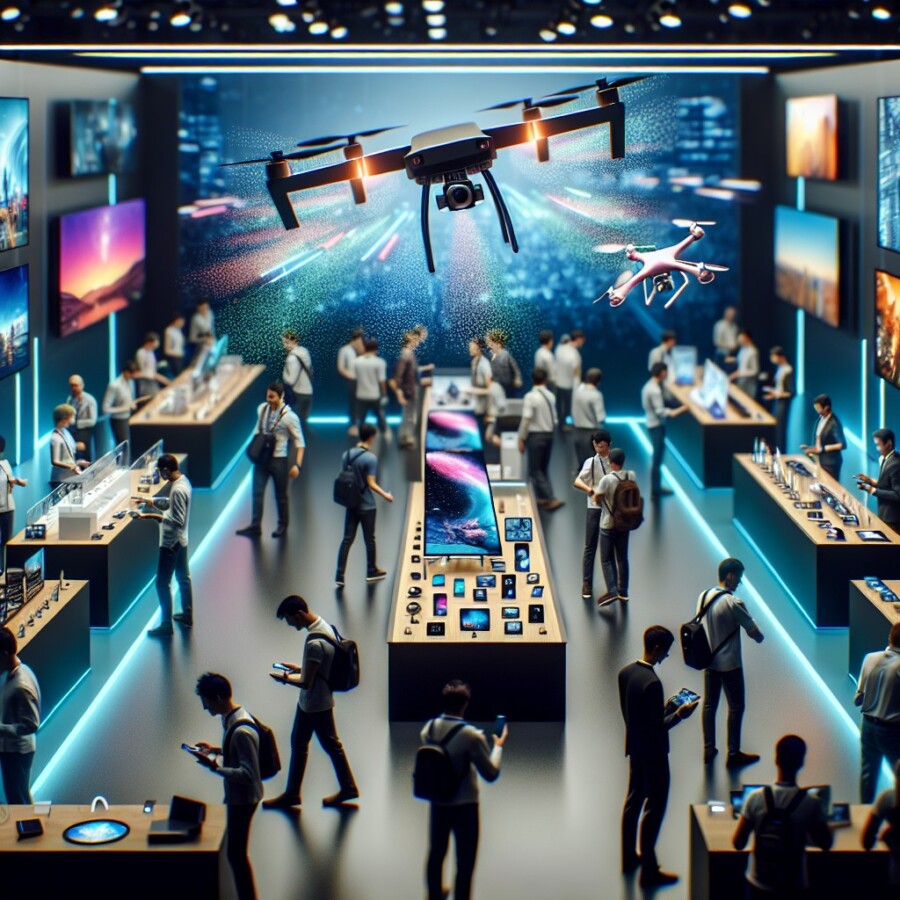The Consumer Electronics Show (CES) is an annual event where the tech industry showcases its latest gadgets. Among the many products on display, there are some that claim to have artificial intelligence (AI) capabilities. For example, Motion Sleep, a South Korean company, has developed an AI pillow that detects snoring and adjusts to alleviate it. Similarly, Samsung has introduced AI-capable household devices such as a vacuum cleaner and a washing machine that can assess different surfaces and fabrics. However, the definition of AI is vague, and many companies are stretching its meaning to attract attention and investment. This has led to concerns about false claims and misleading advertising.
One of the main problems with AI is the lack of a universally accepted definition. This has resulted in a year of hype and companies exaggerating their AI capabilities. The Federal Trade Commission (FTC) in the US has issued advisory notes cautioning companies against making baseless claims about AI. However, the FTC acknowledges that AI is an ambiguous term with multiple definitions, which further complicates the issue. As a journalist, it is challenging to assess the validity of these claims when companies provide little evidence to support them.
Some companies are starting to move away from using the term AI and instead focus on specific AI techniques or models. For example, Rabbit’s R1 device uses generative AI but does not heavily emphasize the term AI in its marketing. Similarly, Samsung’s fridge that analyzes food and suggests recipes is a clear example of AI in action. However, the question arises as to whether consumers actually need their fridge to provide recipe suggestions.
In conclusion, while there are many products claiming to have AI capabilities at CES, the definition of AI remains vague, and companies may be stretching the term to attract attention. The lack of a clear definition makes it difficult for consumers and journalists to assess the validity of these claims. Some companies are already moving away from using the term AI and focusing on specific AI techniques instead. Ultimately, consumers will decide whether they truly need AI-enabled products or if traditional, non-AI devices are sufficient for their needs.
Original news source: CES 2024: AI pillows and toothbrushes – is it all getting a bit silly? (BBC)
🎧 Listen:
Slow
Normal
Fast
📖 Vocabulary:
| 1 | showcases | Displays or presents prominently |
| 2 | alleviate | To make something less severe or serious |
| 3 | capabilities | The skills or qualities that allow someone or something to perform effectively |
| 4 | assess | To evaluate or estimate the nature, ability, or quality of |
| 5 | vague | Not clear or precise in thought or expression |
| 6 | stretching | Extending or expanding beyond the usual or proper limits |
| 7 | misleading | Giving the wrong idea or impression |
| 8 | advisory | Providing guidance or recommendations on a course of action |
| 9 | exaggerating | To represent something as being larger, better, or worse than it really is |
| 10 | ambiguous | Open to more than one interpretation; not having one obvious meaning |
| 11 | validity | The quality of being logically or factually sound; soundness or cogency |
| 12 | generative | Relating to the production of new data or content by using algorithms |
| 13 | emphasizes | To give special importance or prominence to something in speaking or writing |
| 14 | arises | Comes into being or to be considered |
| 15 | sufficient | Adequate for the purpose; enough |
Group or Classroom Activities
Warm-up Activities:
– News Summary
Instructions:
1. Divide the class into small groups.
2. Give each group a few minutes to read the article.
3. Instruct the groups to summarize the main points of the article in 3-5 sentences.
4. Ask each group to share their summary with the class.
– Opinion Poll
Instructions:
1. Ask the students to form pairs.
2. Assign each pair a topic related to AI (e.g., AI in household devices, AI in healthcare, AI in transportation).
3. Instruct the pairs to discuss their opinions on the topic and come up with at least three reasons to support their viewpoint.
4. After the discussion, ask each pair to present their opinions to the class.
– Sketch It
Instructions:
1. Provide each student with a piece of paper and a pen.
2. Instruct the students to draw a sketch representing their understanding of AI based on the article.
3. After a few minutes, ask the students to share their sketches with a partner and explain their drawings.
4. Encourage a class discussion about the different interpretations of AI.
– Vocabulary Pictionary
Instructions:
1. Write down key vocabulary words from the article on separate pieces of paper.
2. Divide the class into two teams.
3. Call a student from one team to the front of the class.
4. Show the student a vocabulary word without saying it aloud.
5. The student must draw the word on the board while their team tries to guess what it is.
6. If the team guesses correctly, they earn a point. If not, the other team has a chance to steal the point.
7. Repeat with students from the other team until all the vocabulary words have been used.
– Speed Summarizing
Instructions:
1. Divide the class into pairs.
2. Assign one student in each pair as the speaker and the other as the listener.
3. Give the speaker 1-2 minutes to summarize the main points of the article.
4. After the time is up, the listener should summarize what they heard from the speaker.
5. Switch roles and repeat the activity, encouraging the students to summarize the article in different ways each time.
🤔 Comprehension Questions:
1. What is the purpose of the Consumer Electronics Show (CES)?
2. How does Motion Sleep’s AI pillow detect and alleviate snoring?
3. What are some examples of AI-capable household devices introduced by Samsung?
4. Why is there a lack of a universally accepted definition of AI?
5. What has the Federal Trade Commission (FTC) cautioned companies against regarding AI claims?
6. How are some companies moving away from using the term AI in their marketing?
7. What is an example of a specific AI technique or model that Rabbit’s R1 device uses?
8. How does the lack of a clear definition of AI make it difficult for consumers and journalists to assess the validity of claims?
Go to answers ⇩
🎧✍️ Listen and Fill in the Gaps:
The Consumer Electronics Show (CES) is an annual event where the tech industry showcases its latest (1)______. Among the many products on display, there are some that claim to have artificial intelligence (AI) capabilities. For (2)______, Motion Sleep, a (3)______ Korean company, has developed an AI pillow that (4)______ snoring and adjusts to alleviate it. Similarly, Samsung has introduced AI-capable household devices such as a vacuum cleaner and a washing machine that can assess different surfaces and fabrics. However, the definition of AI is vague, and many companies are stretching its meaning to attract attention and investment. This has led to concerns about false (5)______ and misleading advertising.
One of the main (6)______ with AI is the lack of a universally accepted definition. This has resulted in a year of hype and (7)______ exaggerating their AI capabilities. The Federal Trade Commission (FTC) in the US has issued advisory notes cautioning companies against making baseless claims about AI. However, the FTC acknowledges that AI is an ambiguous term with (8)______ definitions, which further complicates the issue. As a journalist, it is challenging to assess the validity of these claims when companies provide little evidence to support them.
Some companies are starting to move away from using the term AI and instead focus on specific AI techniques or models. For example, Rabbit’s R1 device uses generative AI but does not heavily emphasize the term AI in its marketing. Similarly, Samsung’s fridge that analyzes food and (9)______ (10)______s is a (11)______ example of AI in action. However, the (12)______ arises as to whether consumers actually need their fridge to provide recipe suggestions.
In conclusion, while there are many products claiming to have AI capabilities at CES, the (13)______ of AI remains vague, and companies may be stretching the term to attract attention. The lack of a clear definition makes it difficult for consumers and journalists to assess the validity of these claims. Some companies are already (14)______ away from using the term AI and (15)______ on specific AI (16)______ instead. Ultimately, consumers will decide whether they truly need AI-enabled products or if traditional, non-AI devices are sufficient for their needs.
Go to answers ⇩
💬 Discussion Questions:
Students can ask a partner these questions, or discuss them as a group.
1. What is your understanding of artificial intelligence (AI)? How would you define it?
2. Do you think it is important for companies to have a universally accepted definition of AI? Why or why not?
3. How would you feel if you purchased a product that claimed to have AI capabilities but later found out it did not?
4. Do you believe that companies are exaggerating their AI capabilities to attract attention and investment? Why or why not?
5. What evidence would you expect a company to provide to support their claims of AI capabilities?
6. Have you ever encountered a product that claimed to have AI capabilities? If so, what was your experience with it?
7. Do you think it is necessary for companies to focus on specific AI techniques or models rather than using the term AI broadly? Why or why not?
8. How do you think the lack of a clear definition of AI affects consumers’ ability to make informed decisions about products?
9. Would you be more likely to purchase a product that clearly states the specific AI techniques it uses, or one that simply claims to have AI capabilities? Why?
10. How important is it for companies to be transparent about the AI capabilities of their products? Why or why not?
11. Do you think consumers truly need AI-enabled products, or are traditional devices sufficient for their needs? Why or why not?
12. Have you ever used a product that provided recipe suggestions, like Samsung’s fridge? How useful do you find this feature?
13. How do you think companies can avoid misleading advertising when it comes to AI capabilities?
14. Do you think the FTC’s advisory notes are effective in preventing companies from making baseless claims about AI? Why or why not?
15. What factors would you consider when deciding whether or not to purchase an AI-enabled product?
Individual Activities
📖💭 Vocabulary Meanings:
Match each word to its meaning.
Words:
1. showcases
2. alleviate
3. capabilities
4. assess
5. vague
6. stretching
7. misleading
8. advisory
9. exaggerating
10. ambiguous
11. validity
12. generative
13. emphasizes
14. arises
15. sufficient
Meanings:
(A) Displays or presents prominently
(B) To evaluate or estimate the nature, ability, or quality of
(C) Not clear or precise in thought or expression
(D) The skills or qualities that allow someone or something to perform effectively
(E) Relating to the production of new data or content by using algorithms
(F) To make something less severe or serious
(G) Providing guidance or recommendations on a course of action
(H) The quality of being logically or factually sound; soundness or cogency
(I) Extending or expanding beyond the usual or proper limits
(J) To represent something as being larger, better, or worse than it really is
(K) Adequate for the purpose; enough
(L) To give special importance or prominence to something in speaking or writing
(M) Giving the wrong idea or impression
(N) Open to more than one interpretation; not having one obvious meaning
(O) Comes into being or to be considered
Go to answers ⇩
🔡 Multiple Choice Questions:
1. What is the Consumer Electronics Show (CES)?
(a) A conference for software developers
(b) An annual event where the tech industry showcases its latest gadgets
(c) A trade show for the automotive industry
(d) A music festival for electronic music
2. What is one example of a product with AI capabilities mentioned in the article?
(a) Samsung’s AI fridge that suggests recipes
(b) Motion Sleep’s AI pillow that detects snoring
(c) Rabbit’s R1 device that uses generative AI
(d) All of the above
3. What is one concern mentioned in the article about companies claiming to have AI capabilities?
(a) Lack of evidence to support their claims
(b) Stretching the meaning of AI to attract attention and investment
(c) All of the above
(d) False claims and misleading advertising
4. What is one challenge faced by journalists when assessing the validity of companies’ AI claims?
(a) Companies providing little evidence to support their claims
(b) Multiple definitions of AI
(c) Lack of a universally accepted definition of AI
(d) All of the above
5. What is one approach some companies are taking to address the ambiguity of the term AI?
(a) Avoiding the term AI in their marketing
(b) Both (a) and (b)
(c) None of the above
(d) Focusing on specific AI techniques or models
6. What is one example of a specific AI technique mentioned in the article?
(a) Generative AI
(b) Machine learning
(c) Natural language processing
(d) All of the above
7. What is one example of an AI-enabled household device mentioned in the article?
(a) AI pillow that detects snoring
(b) AI vacuum cleaner that assesses different surfaces
(c) AI washing machine that assesses different fabrics
(d) All of the above
8. Who ultimately decides whether consumers need AI-enabled products?
(a) The tech industry
(b) Journalists
(c) Consumers themselves
(d) The Federal Trade Commission (FTC)
Go to answers ⇩
🕵️ True or False Questions:
1. The lack of a universally accepted definition of AI has led to companies exaggerating their AI capabilities.
2. Samsung has not introduced AI-capable household devices such as a vacuum cleaner and a washing machine that can assess different surfaces and fabrics.
3. Some companies are starting to move away from using the term AI and instead focus on specific AI techniques or models.
4. Rabbit’s R1 device uses generative AI but does not heavily emphasize the term AI in its marketing.
5. The lack of a vague definition of AI makes it easy for consumers and journalists to assess the validity of claims made by companies.
6. The Consumer Electronics Show (CES) is not an annual event where the tech industry showcases its latest gadgets.
7. Motion Sleep, a South Korean company, has developed an AI pillow that detects snoring and adjusts to alleviate it.
8. The Federal Trade Commission (FTC) has not issued advisory notes cautioning companies against making baseless claims about AI.
Go to answers ⇩
📝 Write a Summary:
Write a summary of this news article in two sentences.
Check your writing now with the best free AI for English writing!
Writing Questions:
Answer the following questions. Write as much as you can for each answer.
Check your answers with our free English writing assistant!
1. What is the main problem with the use of the term AI in the tech industry?
2. What cautionary measures has the Federal Trade Commission (FTC) taken regarding AI claims?
3. Why are some companies choosing to focus on specific AI techniques instead of using the term AI?
4. What is one example of a product at CES that clearly demonstrates AI capabilities?
5. Who ultimately decides whether consumers need AI-enabled products or not?
✅ Answers
🤔✅ Comprehension Question Answers:
1. What is the purpose of the Consumer Electronics Show (CES)?
The purpose of the Consumer Electronics Show (CES) is for the tech industry to showcase its latest gadgets.
2. How does Motion Sleep’s AI pillow detect and alleviate snoring?
Motion Sleep’s AI pillow detects snoring and adjusts to alleviate it using artificial intelligence capabilities.
3. What are some examples of AI-capable household devices introduced by Samsung?
Some examples of AI-capable household devices introduced by Samsung are a vacuum cleaner and a washing machine that can assess different surfaces and fabrics.
4. Why is there a lack of a universally accepted definition of AI?
There is a lack of a universally accepted definition of AI because the term is ambiguous and can have multiple definitions.
5. What has the Federal Trade Commission (FTC) cautioned companies against regarding AI claims?
The Federal Trade Commission (FTC) has cautioned companies against making baseless claims about AI.
6. How are some companies moving away from using the term AI in their marketing?
Some companies are moving away from using the term AI in their marketing by focusing on specific AI techniques or models instead.
7. What is an example of a specific AI technique or model that Rabbit’s R1 device uses?
An example of a specific AI technique or model that Rabbit’s R1 device uses is generative AI.
8. How does the lack of a clear definition of AI make it difficult for consumers and journalists to assess the validity of claims?
The lack of a clear definition of AI makes it difficult for consumers and journalists to assess the validity of claims because companies can stretch the term and make false or misleading claims about their products’ AI capabilities.
Go back to questions ⇧
🎧✍️✅ Listen and Fill in the Gaps Answers:
(1) gadgets
(2) example
(3) South
(4) detects
(5) claims
(6) problems
(7) companies
(8) multiple
(9) suggests
(10) recipe
(11) clear
(12) question
(13) definition
(14) moving
(15) focusing
(16) techniques
Go back to questions ⇧
📖💭✅ Vocabulary Meanings Answers:
1. showcases
Answer: (A) Displays or presents prominently
2. alleviate
Answer: (F) To make something less severe or serious
3. capabilities
Answer: (D) The skills or qualities that allow someone or something to perform effectively
4. assess
Answer: (B) To evaluate or estimate the nature, ability, or quality of
5. vague
Answer: (C) Not clear or precise in thought or expression
6. stretching
Answer: (I) Extending or expanding beyond the usual or proper limits
7. misleading
Answer: (M) Giving the wrong idea or impression
8. advisory
Answer: (G) Providing guidance or recommendations on a course of action
9. exaggerating
Answer: (J) To represent something as being larger, better, or worse than it really is
10. ambiguous
Answer: (N) Open to more than one interpretation; not having one obvious meaning
11. validity
Answer: (H) The quality of being logically or factually sound; soundness or cogency
12. generative
Answer: (E) Relating to the production of new data or content by using algorithms
13. emphasizes
Answer: (L) To give special importance or prominence to something in speaking or writing
14. arises
Answer: (O) Comes into being or to be considered
15. sufficient
Answer: (K) Adequate for the purpose; enough
Go back to questions ⇧
🔡✅ Multiple Choice Answers:
1. What is the Consumer Electronics Show (CES)?
Answer: (b) An annual event where the tech industry showcases its latest gadgets
2. What is one example of a product with AI capabilities mentioned in the article?
Answer: (b) Motion Sleep’s AI pillow that detects snoring
3. What is one concern mentioned in the article about companies claiming to have AI capabilities?
Answer: (d) False claims and misleading advertising
4. What is one challenge faced by journalists when assessing the validity of companies’ AI claims?
Answer: (c) Lack of a universally accepted definition of AI
5. What is one approach some companies are taking to address the ambiguity of the term AI?
Answer: (d) Focusing on specific AI techniques or models
6. What is one example of a specific AI technique mentioned in the article?
Answer: (a) Generative AI
7. What is one example of an AI-enabled household device mentioned in the article?
Answer: (a) AI pillow that detects snoring
8. Who ultimately decides whether consumers need AI-enabled products?
Answer: (c) Consumers themselves
Go back to questions ⇧
🕵️✅ True or False Answers:
1. The lack of a universally accepted definition of AI has led to companies exaggerating their AI capabilities. (Answer: True)
2. Samsung has not introduced AI-capable household devices such as a vacuum cleaner and a washing machine that can assess different surfaces and fabrics. (Answer: False)
3. Some companies are starting to move away from using the term AI and instead focus on specific AI techniques or models. (Answer: True)
4. Rabbit’s R1 device uses generative AI but does not heavily emphasize the term AI in its marketing. (Answer: True)
5. The lack of a vague definition of AI makes it easy for consumers and journalists to assess the validity of claims made by companies. (Answer: False)
6. The Consumer Electronics Show (CES) is not an annual event where the tech industry showcases its latest gadgets. (Answer: False)
7. Motion Sleep, a South Korean company, has developed an AI pillow that detects snoring and adjusts to alleviate it. (Answer: True)
8. The Federal Trade Commission (FTC) has not issued advisory notes cautioning companies against making baseless claims about AI. (Answer: False)
Go back to questions ⇧













